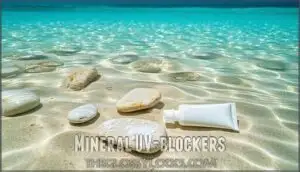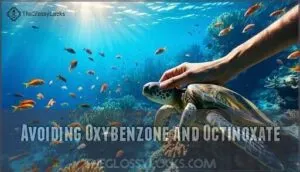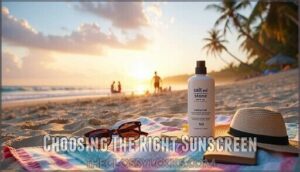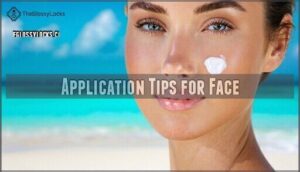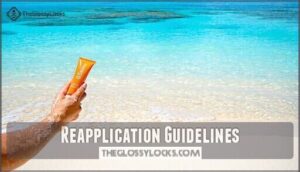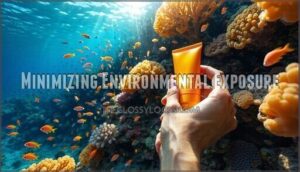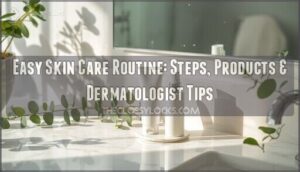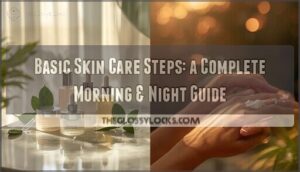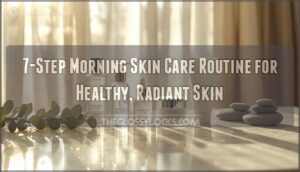This site is supported by our readers. We may earn a commission, at no cost to you, if you purchase through links.
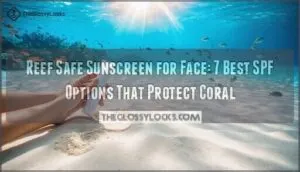
These ingredients protect your skin from sunburn and don’t harm coral reefs. Avoid sunscreens with oxybenzone or octinoxate, since studies link them to coral bleaching.
Look for broad-spectrum SPF and gentle formulas, especially if you have sensitive skin. Brands like All Good, Thinksport, and Blue Lizard offer solid choices.
It’s like giving your skin armor while letting the ocean breathe easy. Curious which SPF fits your routine or how to apply it for best results? Keep reading to find out more about reef safe options.
Table Of Contents
Key Takeaways
- Choose mineral sunscreens with non-nano zinc oxide or titanium dioxide to protect your skin and coral reefs.
- Skip products with oxybenzone, octinoxate, and other harsh chemicals—they harm marine life and your skin.
- Check for broad-spectrum SPF and gentle, fragrance-free formulas, especially if you’ve got sensitive skin.
- Reapply every two hours, use enough for full coverage, and always read labels for true reef-safe protection.
Reef Safe Sunscreen Basics
You’ll want to choose reef safe sunscreens that use mineral-based ingredients like non-nano zinc oxide and titanium dioxide instead of chemical filters.
Protect your skin and the ocean by picking mineral sunscreens with non-nano zinc oxide or titanium dioxide.
These physical blockers protect your skin while keeping harmful chemicals like oxybenzone and octinoxate out of ocean waters where they damage coral reefs.
Non-nano Zinc Oxide Benefits
When you choose nonnano zinc oxide for face sunscreen reef safe protection, you’re selecting nature’s most effective mineral barrier.
This safe alternative creates superior skin protection through its larger particle size, which prevents UV absorption into your skin while supporting reef conservation efforts.
Its effectiveness stems from its ability to block both UVA and UVB rays, offering broad spectrum protection.
- Physical Shield: Creates an immediate protective barrier that reflects harmful UV rays away from your face
- Gentle Guardian: Won’t penetrate your skin like chemical filters, making it perfect for sensitive or acne-prone skin
- Ocean’s Ally: Large particles can’t be absorbed by coral, keeping marine ecosystems healthy and thriving
Titanium Dioxide Advantages
Titanium dioxide functions as your second line of defense in mineral sunscreen face formulations.
This physical UV blocker excels at UVB protection while offering immediate coverage upon application.
Unlike chemical filters, titanium dioxide sunscreen maintains formulation stability and suits those with skin sensitivity concerns.
| Aspect | Benefit | Consideration |
|---|---|---|
| UVB Protection | Reflects harmful rays effectively | Less UVA coverage than zinc oxide |
| Skin Sensitivity | Hypoallergenic, gentle formula | Ideal for sensitive and acne-prone skin |
| Particle Size | Non-nano versions are reef-safe | Nano particles raise environmental concerns |
| Formulation Stability | Photostable, doesn’t degrade | Maintains protection throughout sun exposure |
| Environmental Impact | Non-nano forms protect coral reefs | Choose verified non-nano formulations |
The key lies in selecting non-nano titanium dioxide formulations that balance effective protection with environmental responsibility.
These zinc oxide sunscreen alternatives provide reliable coverage without compromising marine ecosystems.
Selecting sunscreens with these minerals helps to guarantee effective UV protection without harming marine life.
Harmful Ingredients to Avoid
While mineral filters like zinc oxide are safe, watch out for sunscreen ingredients to avoid.
Oxybenzone Concerns and Octinoxate Risks top the list, since these chemical filters harm coral reefs.
Homosalate Dangers, Parabens Effects, and Nanoparticle Toxicity also matter.
Skip oxybenzone, octinoxate, and other harsh chemicals for a truly reef safe sunscreen that protects both your skin and the ocean.
Key Ingredients for Face
When picking a reef safe sunscreen for your face, you’ll want to look for non-nano zinc oxide or titanium dioxide as the main active ingredients.
It’s also smart to avoid harsh chemicals like oxybenzone and octinoxate, which can harm both your skin and coral reefs.
Mineral UV-blockers
When protecting your face and the reefs, mineral UV-blockers are your best bet.
They work by sitting on top of your skin, reflecting the sun’s rays.
Look for:
- Zinc oxide for broad UV spectrum coverage
- Titanium dioxide in non-nano form for reef friendly sunscreen
- Larger particle size for safer marine impact
Mineral-based, non-nano titanium and zinc are reliable choices.
Many sunscreens offer broad-spectrum protection.
Natural Ingredients Like Coconut Oil
You’ll spot coconut oil in many reef safe sunscreen and natural sunscreen face formulas.
It hydrates, soothes, and supports your skin barrier.
But it’s not a strong UV blocker alone.
Coconut Oil Benefits include deep moisturization and gentle care, yet some folks with skin sensitivity may react.
Check this table for more:
| Coconut Oil Benefits | Alternative Oils | Sourcing Concerns | Formulation Challenges | Skin Sensitivity |
|---|---|---|---|---|
| Deep hydration | Jojoba, Olive | Fair trade, organic | Greasiness, stability | May clog pores |
| Soothes skin | Sunflower | Deforestation | Mixing with minerals | Rare allergy |
| Antioxidant-rich | Almond | Worker welfare | Even texture | Acne-prone risk |
| Biodegradable | Avocado | Local sourcing | Scent preferences | Patch test first |
| Coral friendly | Shea butter | Supply chain | Consistency | Not for everyone |
The Coconut Oil Benefits table highlights various aspects, including deep hydration, soothes skin, and antioxidant-rich properties, as well as concerns like skin sensitivity and formulation challenges.
Avoiding Oxybenzone and Octinoxate
After exploring natural ingredients, it’s smart to watch out for chemical sunscreen dangers.
Oxybenzone and octinoxate, two common UV filters, are linked to reef damage and face increasing regulatory sunscreen bans.
For reef safe sunscreen face products, look for:
- Alternative UV filters
- Sunscreen without chemicals
- Clear reef safe labeling
Top 7 Reef Safe Sunscreens
You want sunscreen that protects your skin and doesn’t harm coral reefs, but finding the right one can be tricky.
Here are seven reef safe sunscreens for your face, each meeting strict ingredient standards and offering reliable sun protection.
1. All Good SPF 50 Sunscreen Stick
If you want a sunscreen stick that’s gentle on your skin and the ocean, All Good SPF 50 Sunscreen Stick is a solid choice.
It uses non-nano zinc oxide for broad-spectrum protection, and it’s packed with coconut oil and chamomile to soothe sensitive faces.
The stick glides on easily, though you might notice a faint white cast at first—it blends in with a little effort.
It’s water-resistant for 80 minutes, fragrance-free, and safe for both kids and adults.
Best For: Parents, outdoor enthusiasts, and sensitive skin users who want a reef-safe mineral sunscreen for face and body.
- Gentle, moisturizing formula made with non-nano zinc oxide and botanical oils.
- Water-resistant for 80 minutes, ideal for swimming and beach days.
- Reef-friendly, cruelty-free, and safe for kids and sensitive skin.
- Leaves a temporary white cast that requires some blending.
- Can be thick and slightly hard to apply in cold weather.
- Costs more per ounce than many traditional sunscreen sticks.
2. Thinksport SPF 50 Mineral Sunscreen
Thinksport SPF 50 Mineral Sunscreen is a solid choice if you need high protection and peace of mind for sensitive skin.
It uses 20% non-nano zinc oxide, so you’re shielding your face without risking coral reefs.
The formula is thick but blends in with a little patience, and it’s water-resistant for up to 80 minutes.
There’s no strong scent or greasy feel, and it’s free from harsh chemicals, making it dermatologist-tested, vegan, and Leaping Bunny certified—great for daily, family, or outdoor use.
Best For: People with sensitive skin, families, and anyone needing long-lasting, reef-safe SPF 50 protection for daily or outdoor activities.
- Gentle, non-toxic formula is safe for sensitive skin and kids.
- Water-resistant for 80 minutes, ideal for sports and swimming.
- Free from harsh chemicals, vegan, and Leaping Bunny certified.
- Thick texture can leave a white cast, especially on darker skin tones.
- Needs extra effort to blend in and remove after use.
- Can sting if it gets into eyes during heavy sweating.
3. Mineral Zinc Sunscreen Broad Spectrum SPF 30
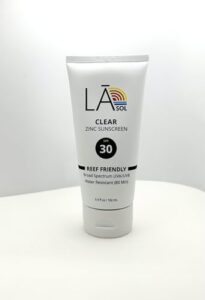
Anyone searching for a gentle, reliable sunscreen will appreciate Mineral Zinc Sunscreen Broad Spectrum SPF 30.
This clear, fragrance-free lotion uses non-nano zinc oxide as its only active ingredient, giving you broad-spectrum protection without the white streaks.
It’s water-resistant for 80 minutes, so you can swim or sweat without worry.
The formula skips harsh chemicals, parabens, and fragrances, making it a safe pick for sensitive skin.
It layers well under makeup and washes off easily, leaving skin comfortable and protected.
Best For: Those with sensitive skin, kids, or anyone seeking a clean, reef-safe sunscreen for face or body.
- Gentle, fragrance-free, and safe for all skin types, including sensitive and eczema-prone.
- Provides clear, broad-spectrum SPF 30 protection without leaving a white cast.
- Water-resistant for 80 minutes and works well under makeup.
- Higher price point with additional shipping fees, making it best for selective use.
- Can appear slightly shiny or greasy after application, especially on facial hair.
- Runny consistency requires careful handling to prevent leaks.
4. Soleil Toujours SPF 30 Sunscreen Mist

Soleil Toujours SPF 30 Sunscreen Mist stands out if you’re after a reef-safe, user-friendly option.
Its lightweight, hydrating formula absorbs quickly, leaving no sticky residue or white cast—so you won’t look like a ghost at the beach.
It’s vegan, water-resistant, and free from oxybenzone, octinoxate, and octocrylene, meeting Hawaii’s strict reef safety standards.
With antioxidant-rich ingredients and a clear finish, it’s a great pick for sensitive skin and active days.
Plus, the recyclable packaging helps keep oceans cleaner.
Best For: People seeking a clean, reef-safe sunscreen that works for sensitive skin, outdoor activities, and daily use.
- Lightweight, hydrating formula absorbs quickly and leaves no white residue.
- Reef-safe, vegan, and environmentally friendly with recyclable packaging.
- Long-lasting water resistance and less frequent reapplication needed.
- Higher price point than many alternatives.
- Not fragrance-free, despite being subtle.
- Only available in SPF 30, which may not be high enough for everyone.
5. Blue Lizard Sensitive Mineral Sunscreen
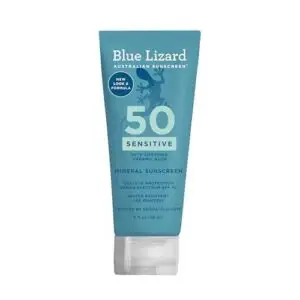
Blue Lizard’s Sensitive Mineral Sunscreen stands out for its gentle, no-nonsense formula.
You get broad-spectrum SPF 50 protection with only zinc oxide and titanium dioxide—no harsh chemicals like oxybenzone or octinoxate.
It’s fragrance-free, hypoallergenic, and loaded with soothing aloe vera, making it ideal for sensitive faces, kids, or anyone prone to sunscreen rashes.
The thick texture takes some rubbing, but it blends in with patience.
The smart cap turns blue in sunlight, reminding you to reapply before you burn.
Best For: People with sensitive, allergy-prone skin or those seeking a gentle, chemical-free sunscreen for daily or outdoor use.
- Mineral-only SPF 50 protection without harsh chemicals.
- Hypoallergenic, fragrance-free, and safe for kids and adults.
- Smart cap turns blue in sunlight as a reminder to reapply.
- Thick texture requires extra rubbing to blend in.
- Can leave an initial white cast, especially on deeper skin tones.
- Higher price point for the amount provided.
6. Cay Skin Travel Sunscreen Stick SPF 35
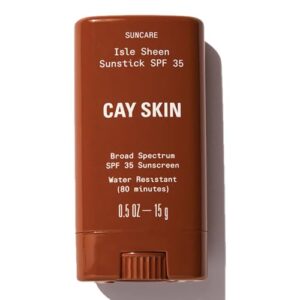
When you’re on the go, the Cay Skin Travel Sunscreen Stick SPF 35 slips easily into your pocket or bag.
Its clear, non-greasy formula glides smoothly over your face, even on top of makeup, and won’t leave a white cast.
The stick is loaded with skin-loving ingredients like sea moss, aloe, and jojoba oil.
It’s vegan, cruelty-free, and meets Hawaii’s reef-safe standards—though it uses chemical filters, not minerals.
Great for quick touch-ups, but the small size means frequent users may run out quickly.
Best For: Quick on-the-go sunscreen touch-ups, especially for those with sensitive or blemish-prone skin looking for a clear, portable option.
- Leaves no white cast and glides easily over makeup for mess-free reapplication
- Vegan, cruelty-free, and compliant with Hawaii’s reef-safe regulations
- Hydrating formula with sea moss, jojoba oil, and aloe for healthy skin
- Small size and low product volume may not last long for daily or frequent users
- Higher price per ounce compared to standard sunscreens
- Chemical filters, not minerals, may not suit those with sensitivities or seeking fully mineral protection
7. Suntegrity Mineral Sunscreen Body 3oz
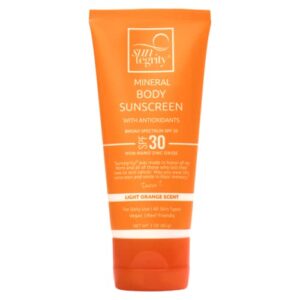
If you’re on the hunt for a gentle, reef-safe sunscreen, Suntegrity Mineral Sunscreen Body 3oz is worth a look.
It uses 20% non-nano zinc oxide for broad-spectrum SPF 30 protection and skips harsh chemicals like oxybenzone and parabens.
The formula’s lightweight, non-greasy, and blends in better than most mineral sunscreens—though you might see a slight white cast.
It’s vegan, cruelty-free, and packed with soothing ingredients like aloe and green tea.
Perfect for sensitive skin, travel, and anyone wanting safe, daily sun defense.
Best For: People with sensitive skin or chemical sunscreen allergies who want a reef-friendly, vegan option for safe daily sun protection.
- Broad-spectrum SPF 30 with 20% non-nano zinc oxide and no harsh chemicals
- Lightweight, non-greasy feel with soothing ingredients like aloe and green tea
- Highly rated for safety by EWG, vegan and cruelty-free
- May leave a slight white cast, more noticeable on deeper skin tones
- Not waterproof; reapplication needed after swimming or sweating
- Higher price and limited availability compared to generic sunscreens
Choosing The Right Sunscreen
When you’re picking a reef safe sunscreen for your face, it’s important to look for options that balance strong sun protection with safe ingredients.
You’ll want to check the label for SPF, mineral-based filters, and details about the brand’s environmental impact.
SPF and Broad-spectrum Protection
After checking out the top reef safe sunscreen picks, let’s talk SPF and broad-spectrum protection.
For real sun protection face care, you want:
- SPF Efficacy of 30 or higher for reliable Protection Levels
- Broad-spectrum Coverage that shields from both UVA Protection and UVB Protection
- Labels that clearly state “broad spectrum sunscreen” for all-around defense
Your skin—and the reefs—will thank you.
For those with sensitive skin, consider options with mineral sunscreen ingredients.
Ingredient Quality and Safety
When choosing reef safe sunscreen, always check for non-nano mineral particle size—this matters for both skin and coral health.
Go for mineral sunscreen with hypoallergenic ingredients and clear certification standards.
Seek sunscreen without chemicals like oxybenzone. Ingredient sourcing ethics matter, too.
Chemical filter alternatives should be non toxic. Reliable brands list all sunscreen ingredients, helping you make safe, informed choices.
Many prefer a mineral sunscreen face product for daily use.
Texture, Application, and Wearability
Once you’ve checked ingredient safety, pay close attention to sunscreen texture and application ease.
Many reef safe sunscreen for face options feel thicker, but newer formulas blend better, leaving less white cast.
Dab and rub in sections to avoid residue transfer.
Daily wear is more comfortable now, with lightweight, non-greasy skin feel.
Wearability matters—especially if you’re outdoors often.
Many people now prefer a mineral based option, which is a mineral based choice for face protection.
Environmental Impact of The Brand
After considering texture and wearability, it’s smart to look at a brand’s environmental impact.
Brands making reef safe sunscreen often use sustainable packaging, reduce their carbon footprint, and focus on ethical sourcing.
Ocean conservation and ingredient biodegradability matter, too.
Eco friendly sunscreen choices support coral reefs, so pick brands that put sustainability first, not just a catchy label.
Applying Reef Safe Sunscreen
When you apply reef safe sunscreen to your face, you help protect both your skin and the ocean.
Choosing reef safe sunscreen means caring for your skin and keeping our oceans vibrant for future generations.
It’s important to use the right amount and reapply as needed for the best results.
Application Tips for Face
For even protection, use a nickel-sized application amount of reef safe sunscreen for your face.
Dot it across your cheeks, nose, and forehead, then use gentle blending techniques to avoid streaks.
Steer clear of your eyes—nobody likes a sting.
If you have sensitive skin, choose a facial sunscreen made for it.
Proper application guarantees complete facial coverage and ensures complete protection.
Layer makeup only after sunscreen application dries, following the proper application guidelines.
Reapplication Guidelines
Since frequency matters, you’ll want to reapply facial sunscreen every two hours, especially with extended exposure or after swimming and sweating.
Sweat resistance helps, but water reapplication is key if you’re active.
For daily sunscreen face routines, don’t skip reapplication—even on cloudy days, to keep your protection strong, no matter your activity levels or the weather.
These sunscreen tips keep your protection strong, no matter your activity levels or the weather.
Minimizing Environmental Exposure
After reapplying, think about how your choices affect coral reefs and marine life.
Skip sprays to limit aerosol dispersal and stick with lotions. Choose reef safe sunscreen with ecofriendly packaging to cut down on packaging waste.
Look for certification seals and responsible ingredient sourcing. Apply sunscreen away from the water to help with runoff prevention—every bit helps protect our oceans.
For daily use, consider sunscreens offering broad-spectrum protection for ecofriendly and broad-spectrum benefits.
Frequently Asked Questions (FAQs)
What sunscreen is reef-safe for face?
You might wonder if all sunscreens are safe for reefs, but not quite.
For your face, pick a mineral sunscreen with non-nano zinc oxide or titanium dioxide, fragrance-free, and no oxybenzone, octinoxate, or parabens.
Is Cerave sunscreen reef-safe?
Cerave sunscreen isn’t always reef-safe.
Some formulas contain ingredients like homosalate or octocrylene, which can harm coral reefs.
Always check the label for non-nano zinc oxide or titanium dioxide if you want true reef-friendly protection.
Is Cetaphil face sunscreen reef-safe?
Cetaphil face sunscreen usually relies on chemical filters like oxybenzone and octinoxate, which aren’t considered reef-safe.
If you’re heading to the ocean, check the label and pick a mineral-based, non-nano zinc oxide formula instead.
Is only reef-safe sunscreen sold in Hawaii?
About 14,000 tons of sunscreen end up in oceans yearly.
In Hawaii, you’ll only find reef-safe sunscreens for sale—those without oxybenzone and octinoxate—thanks to a state law protecting coral reefs from harmful chemicals.
Can reef safe sunscreen be worn under makeup?
You can wear reef safe sunscreen under makeup.
Just let it absorb for a few minutes first.
It acts like a primer, creating a smooth base.
Choose a non-greasy, fragrance-free formula to avoid pilling or irritation.
Does reef safe sunscreen expire or lose effectiveness?
Sunscreen does expire, and after the date on the tube, it starts losing its punch.
You’ll want to check the label, because using old sunscreen is like locking the barn door after the horse has bolted.
Are reef safe sunscreens safe for children’s faces?
You’d think a child’s face is as delicate as a butterfly’s wing, right?
Evidence shows most reef safe sunscreens with non-nano zinc oxide or titanium dioxide are gentle for kids’ faces—just check for fragrance-free, hypoallergenic labels.
Conclusion
Did you know that up to 14,000 tons of sunscreen end up in coral reefs each year?
Choosing a reef safe sunscreen for face helps protect both your skin and the ocean. Stick with mineral options like non-nano zinc oxide or titanium dioxide, and avoid harmful chemicals.
Look for broad-spectrum SPF and gentle formulas. By making informed choices, you support healthier skin and coral reefs.
Every small step counts in the context of sun safety and marine conservation.
- https://hawaii.com/reef-safe-sunscreen/
- https://www.nps.gov/puho/learn/nature/protectyourselfprotectthereef.htm
- https://www.wedu.org/blogs/sustain/ecofriendly-sunscreen/
- https://www.surfrider.org/news/surfrider-foundations-2025-reef-friendly-sunscreen-guide
- https://www.littleurchin.com.au/blogs/news/5-benefits-of-the-best-reef-safe-sunscreens

